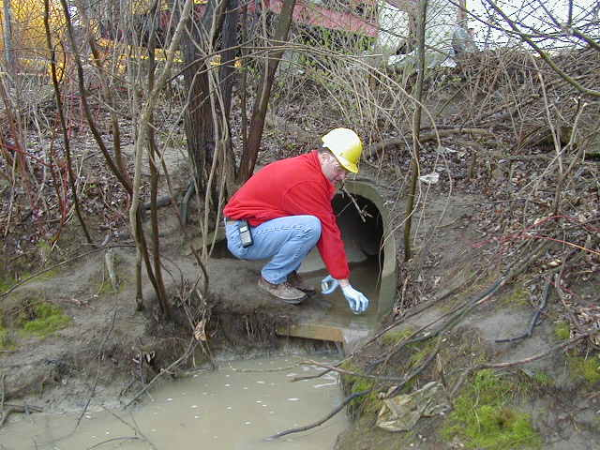We explain how to measure pH in stormwater samples.
We do a fair amount of stormwater work across the country for our clients, including obtaining and testing their stormwater samples at some facilities. Regardless of where we're working, we find a fair amount of our new and old clients struggle with getting good, accurate, and reliable measurements of the pH of their stormwater.
And it makes sense. It can be somewhat tricky, especially if your facility doesn't discharge often, or if you're new to the job. It's important to nail this down though, because the results can be very important.
Most likely the only reason why you would be measuring pH in the first place is to be compliant with the regulations set by your NPDES permit. Your stormwater permit sets limits for the range of pH results deemed acceptable, so doing it correctly and getting good, accurate measurements are crucial to keep you in compliance, and avoid any fines, penalties, or violations.
Measuring pH in a Stormwater Sample
The USEPA has a list of standard testing methods that list approved protocols for measuring the pH of stormwater. Here is a simplified step by step method on how to correctly measure pH:
1 - Calibrate Your pH Meter
Most of you are probably thinking that this step might go without saying, but a lot of people skip this and it can really screw up your results. We believe and urge our customers to be prepared before gathering their samples. Having all your paperwork and forms in order, and your pH meter calibrated before you obtain your sample will save you time that is needed to conduct your analysis. After you get your sample, you will only have 15 minutes to measure the pH, so preparing beforehand will save you crucial time, when you don’t have a lot to begin with.
2 - Get a Valid Stormwater Sample
Stormwater permits require you to get samples during valid storm events, so it is important to know what those are. You can find that information in your permit, so make sure you read it and are familiar with what you have to do. Your best samples are coming to come from using clean, designated bottles to gather your stormwater discharge in. Any liquid or residue in bottles you use can drastically change the pH of your sample, so it is very important to have clean bottles to gather your samples in.
When you go to get your sample, it's important to rinse the bottle three times, at a minimum, with the stormwater being sampled. That will ensure your bottles are cleaned of any residue and contain only the water you want to sample. Again, sounds silly, but it can make a huge difference.

3 - Perform a pH Analysis of the Stormwater Sample
Now that you’ve obtained your sample, the clock starts and you only have 15 minutes to perform this analysis. Read our other blog, Does the pH of a stormwater sample change over time? Why 15 minutes are crucial if you’re not sure why those 15 minutes are truly important.
There are proper techniques to use when performing the analysis:
- Run duplicate samples. Simply enough, divide your sample in two and perform the test twice on both samples, and record both results.
- Swirl the sample around during the analysis. Mix it up and keep the water moving. Nothing crazy, just a light swirling motion.
- Allow the meter reading to stabilize. Once you put the meter in the sample, the numbers are going to jump around. It's very important to let the meter reading stabilize before continuing on.
- Clean all equipment after use. Don't skimp! This will ensure you have clean equipment for the next time you need to sample.
4 - Record ALL pH Results
Yes, you need to record both good and bad results!
Your stormwater permit will require you to report the results you get, this means all of them. If you perform the analysis and get a bad result, you can’t just do it again and act like that never happened, you need to report all sample results you get. If you don't, you could get in serious, serious trouble (fines, criminal investigations, you name it). You’ll receive forms to report on from your regulatory agency, which will contain information for where and when to submit your results.

Proper Measurement of pH in Stormwater
It is very, very important to ensure that the way you measure pH falls under the guidelines set forth by the USEPA protocols (Standard Method (SM) 4500 H-B-11) as well as your state's requirements. If you aren't following those requirements, you're not in compliance, and it's only a matter of time before you'll get in trouble for not following the rules. It may take a little longer, you may have to buy a pH meter (we have a personal favorite and think this is the best pH meter for stormwater sampling), but in the long run, it'll save you time, energy, and most importantly money, if you just follow the rules.
Remember; prepare beforehand, collect your samples, perform the analysis, and record your results. It's not that hard as long as you follow those 4 simple steps.

pH Analysis Training
While pH analysis isn't overly difficult to do, you still need to understand the basics - calibrating your meter, testing samples the correct way, and understanding your results. Many businesses that collect and analyze their discharge samples for pH on-site can (and do!) benefit from pH analysis training.
For a full breakdown of exactly what you’ll need to do to analyze the pH of your samples on-site, be sure to check out our online training course: The Best Way to Perform pH Analyses of Your Facility’s Discharge Samples. We cover all of the steps that we outlined here in detail so that you can be sure you know exactly what you're doing the next time you need to analyze pH at your site.
Need help with stormwater permit compliance?
For a lot of folks out there, this is a pain to deal with. After all, you have a business to run! If you're overwhelmed, you're not alone. RMA has been actively involved in helping companies get and stay in compliance with stormwater permits across the United States since our founding in 1992. Long story short, we know the ins and outs of the environmental problems industrial and commercial facilities face and can help you get into compliance with stormwater permits and other applicable environmental laws and regulations, ensuring your business stays out of trouble and in compliance.
Our staff members have been on-site at thousands of operations across the country, so when we say we've seen it all and done it all, we mean it. We've helped everyone, from globe-spanning, multi-national organizations to small "mom & pop" operations. No matter your size or location, we'd love to learn how we can help.
So, if you're having any type of issue at your facility and need the help of an environmental consulting firm with a proven track record, reach out. Even if we can't help, we’ll do our best to steer you in the right direction. Feel free to contact us at info@rmagreen.com, click here to contact us, or give us a call anytime at 888-RMA-0230 to learn how we can help your facility deal with stormwater permits and other environmental regulations.
Additional Stormwater Permit Information













